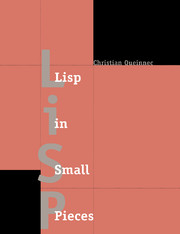Book contents
- Frontmatter
- Contents
- To the Reader
- 1 The Basics of Interpretation
- 2 Lisp, 1, 2, … ω
- 3 Escape & Return: Continuations
- 4 Assignment and Side Effects
- 5 Denotational Semantics
- 6 Fast Interpretation
- 7 Compilation
- 8 Evaluation & Reflection
- 9 Macros: Their Use & Abuse
- 10 Compiling into C
- 11 Essence of an Object System
- Answers to Exercises
- Bibliography
- Index
To the Reader
Published online by Cambridge University Press: 05 June 2012
- Frontmatter
- Contents
- To the Reader
- 1 The Basics of Interpretation
- 2 Lisp, 1, 2, … ω
- 3 Escape & Return: Continuations
- 4 Assignment and Side Effects
- 5 Denotational Semantics
- 6 Fast Interpretation
- 7 Compilation
- 8 Evaluation & Reflection
- 9 Macros: Their Use & Abuse
- 10 Compiling into C
- 11 Essence of an Object System
- Answers to Exercises
- Bibliography
- Index
Summary
Even though the literature about Lisp is abundant and already accessible to the reading public, nevertheless, this book still fills a need. The logical substratum where Lisp and Scheme are founded demand that modern users must read programs that use (and even abuse) advanced technology, that is, higher-order functions, objects, continuations, and so forth. Tomorrow's concepts will be built on these bases, so not knowing them blocks your path to the future.
To explain these entities, their origin, their variations, this book will go into great detail. Folklore tells us that even if a Lisp user knows the value of every construction in use, he or she generally does not know its cost. This work also intends to fill that mythical hole with an in-depth study of the semantics and implementation of various features of Lisp, made more solid by more than thirty years of history.
Lisp is an enjoyable language in which numerous fundamental and non-trivial problems can be studied simply. Along with ML, which is strongly typed and suffers few side effects, Lisp is the most representative of the applicative languages. The concepts that illustrate this class of languages absolutely must be mastered by students and computer scientists of today and tomorrow. Based on the idea of “function,” an idea that has matured over several centuries of mathematical research, applicative languages are omnipresent in computing; they appear in various forms, such as the composition of UN⋆X byte streams, the extension language for the EMACS editor, as well as other scripting languages.
Information
- Type
- Chapter
- Information
- Lisp in Small Pieces , pp. xiii - xxPublisher: Cambridge University PressPrint publication year: 1996
